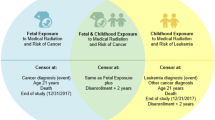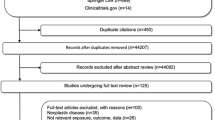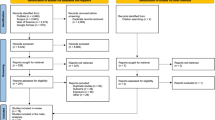Abstract
Background
Ionizing radiation use for medical diagnostic purposes has substantially increased over the last three decades. Moderate to high doses of radiation are well established causes of cancer, especially for exposure at young ages. However, cancer risk from low-dose medical imaging is debated.
Objective
To review the literature on cancer risks associated with prenatal and postnatal medical diagnostic ionizing radiation exposure among children and to assess this risk through a meta-analysis.
Materials and methods
A literature search of five electronic databases supplemented by a hand search was performed to retrieve relevant epidemiological studies published from 2000 to 2019, including patients younger than 22 years of age exposed to medical imaging ionizing radiation. Pooled odds ratio (ORpooled) and pooled excess relative risk (ERRpooled) representing the excess of risk per unit of organ dose were estimated with a random effect model.
Results
Twenty-four studies were included. For prenatal exposure (radiographs or CT), no significant increased risk was reported for all cancers, leukemia and brain tumors. For postnatal exposure, increased risk was observed only for CT, mostly for leukemia (ERRpooled=26.9 Gy−1; 95% confidence interval [CI]: 2.7–57.1) and brain tumors (ERRpooled=9.1 Gy−1; 95% CI: 5.2–13.1).
Conclusion
CT exposure in childhood appears to be associated with increased risk of cancer while no significant association was observed with diagnostic radiographs.





Similar content being viewed by others
Explore related subjects
Discover the latest articles and news from researchers in related subjects, suggested using machine learning.Change history
22 October 2020
The original version of Table 2 included two incorrect values.
References
Hall EJ, Brenner DJ (2008) Cancer risks from diagnostic radiology. Br J Radiol 81:362–378
United Nations Scientific Committee on the Effects of Atomic Radiation (2008) Effects of ionizing radiation: United Nations Scientific Committee on the Effects of Atomic Radiation—UNSCEAR 2006 report, volume 1—report to the general assembly, with scientific annexes A and B. United Nations Office at Vienna, United Nations
Linet MS, Slovis TL, Miller DL et al (2012) Cancer risks associated with external radiation from diagnostic imaging procedures. CA Cancer J Clin 62:75–100
Institut de Radioprotection et de Sûreté Nucléaire (IRSN) (2015) [Exposure of the French population to ionising radiation.] Fontenay-aux-Roses. https://www.irsn.fr/FR/expertise/rapports_expertise/Documents/radioprotection/IRSN-Exposition-Population-Rayonnements-Ionisants_2015-00001.pdf. Accessed 20 Oct 2018
Watson SJ, Jones AL, Oatway WB, Hughes SJ (2005) Ionising radiation exposure of the UK population: UK review. HPA-RPD-001. Health Protection Agency, Centre for Radiation, Chemical and Environmental Hazards. Chilton, Oxfordshire
Preston DL, Kusumi S, Tomonaga M et al (1994) Cancer incidence in atomic bomb survivors. Part III: leukemia, lymphoma and multiple myeloma, 1950-1987. Radiat Res 137:S68–S97
Folley JH, Borges W, Yamawaki T (1952) Incidence of leukemia in survivors of the atomic bomb in Hiroshima and Nagasaki, Japan. Am J Med 13:311–321
Ozasa K, Shimizu Y, Suyama A et al (2011) Studies of the mortality of atomic bomb survivors, report 14, 1950–2003: an overview of cancer and noncancer diseases. Radiat Res 177:229–243
Wakeford R (2013) The risk of childhood leukaemia following exposure to ionising radiation—a review. J Radiol Prot 33:1–25
Preston DL, Cullings H, Suyama A et al (2008) Solid cancer incidence in atomic bomb survivors exposed in utero or as young children. J Natl Cancer Inst 100:428–436
Stewart A, Webb J, Hewitt D (1958) A survey of childhood malignancies. Br Med J 1:1495–1508
Wakeford R (2008) Childhood leukaemia following medical diagnostic exposure to ionizing radiation in utero or after birth. Radiat Prot Dosim 132:166–174
Giles D, Hewitt D, Stewart A, Webb J (1956) Malignant disease in childhood and diagnostic irradiation in utero. Lancet 271:447
MacMahon B (1962) Prenatal x-ray exposure and childhood cancer. J Natl Cancer Inst 28:1173–1191
Linet MS, Kim KP, Rajaraman P (2009) Children’s exposure to diagnostic medical radiation and cancer risk: epidemiologic and dosimetric considerations. Pediatr Radiol 39:S4–S26
Schulze-Rath R, Hammer GP, Blettner M (2008) Are pre-or postnatal diagnostic X-rays a risk factor for childhood cancer? A systematic review. Radiat Environ Biophys 47:301–312
Baysson H, Etard C, Brisse HJ, Bernier M-O (2012) Diagnostic radiation exposure in children and cancer risk: current knowledge and perspectives. Arch Pediatr 19:64–73
Baysson H, Journy N, Roué T et al (2016) Exposure to CT scans in childhood and long-term cancer risk: a review of epidemiological studies. Bull du Cancer 103:190–198
Bernier M-O, Journy N, Baysson H et al (2015) Potential cancer risk associated with CT scans: review of epidemiological studies and ongoing studies. Prog Nucl Energy 84:116–119
Liberati A, Altman DG, Tetzlaff J et al (2009) The PRISMA statement for reporting systematic reviews and meta-analyses of studies that evaluate health care interventions: explanation and elaboration. PLoS Med 6:e1000100
National Research Council (2006) Health risks from exposure to low levels of ionizing radiation: BEIR VII phase 2. National Academies Press
United Nations Scientific Committee on the Effects of Atomic Radiation (UNSCEAR) (2013) Sources, effects and risks of ionizing radiation: Volume II. Scientific annex B: Effects of radiation exposure of Children. New York
de Gonzalez AB, Salotti JA, McHugh K et al (2016) Relationship between paediatric CT scans and subsequent risk of leukaemia and brain tumours: assessment of the impact of underlying conditions. Br J Cancer 114:388–394
Hammer GP, Seidenbusch MC, Schneider K et al (2009) A cohort study of childhood cancer incidence after postnatal diagnostic X-ray exposure. Radiat Res 171:504–512
Hammer GP, Seidenbusch MC, Regulla DF et al (2011) Childhood cancer risk from conventional radiographic examinations for selected referral criteria: results from a large cohort study. AJR Am J Roentgenol 197:217–223
Infante-Rivard C (2003) Diagnostic x rays, DNA repair genes and childhood acute lymphoblastic leukemia. Health Phys 85:60–64
Infante-Rivard C, Mathonnet G, Sinnett D (2000) Risk of childhood leukemia associated with diagnostic irradiation and polymorphisms in DNA repair genes. Environ Health Perspect 108:495–498
Journy N, Rehel J-L, Le Pointe HD et al (2015) Are the studies on cancer risk from CT scans biased by indication? Elements of answer from a large-scale cohort study in France. Br J Cancer 112:185–193
Journy N, Roué T, Cardis E et al (2016) Childhood CT scans and cancer risk: impact of predisposing factors for cancer on the risk estimates. J Radiol Prot 36:N1–N7
Pearce MS, Salotti JA, Little MP et al (2012) Radiation exposure from CT scans in childhood and subsequent risk of leukaemia and brain tumours: a retrospective cohort study. Lancet 380:499–505
Wells GA, Shea B, O’Connell D et al (2015) The Newcastle-Ottawa Scale (NOS) for assessing the quality of nonrandomized studies in meta-analyses. http://www.ohri.ca/programs/clinical_epidemiology/oxford.asp. Accessed 24 Nov 2018
Viswanathan M, Ansari MT, Berkman ND et al (2012) Assessing the risk of bias of individual studies in systematic reviews of health care interventions. In: Methods guide for effectiveness and comparative effectiveness reviews. https://effectivehealthcare.ahrq.gov/sites/default/files/pdf/methods-guidance-bias-individual-studies_methods.pdf. Accessed 24 Nov 2018
Sterne JA (2009) Meta-analysis in Stata: an updated collection from the Stata journal. StataCorp LP, College Station, Texas
Richardson DB, Abalo K, Bernier M-O et al (2020) Meta-analysis of published excess relative rate estimates. Radiat Environ Biophys. https://doi.org/10.1007/s00411-020-00863-w
Egger M, Davey Smith G, Schneider M, Minder C (1997) Bias in meta-analysis detected by a simple, graphical test. BMJ 315:629–634
Steichen T (1998) Tests for publication bias in meta-analysis. Stata Tech Bull 7:14
Schüz J, Kaletsch U, Kaatsch P et al (2001) Risk factors for pediatric tumors of the central nervous system: results from a German population-based case-control study. Med Pediatr Oncol 36:274–282
Shu XO, Potter JD, Linet MS et al (2002) Diagnostic X-rays and ultrasound exposure and risk of childhood acute lymphoblastic leukemia by immunophenotype. Cancer Epidemiol Biomark Prev 11:177–185
Roman E, Simpson J, Ansell P et al (2005) Perinatal and reproductive factors: a report on haematological malignancies from the UKCCS. Eur J Cancer 41:749–759
Goel R, Olshan AF, Ross JA et al (2009) Maternal exposure to medical radiation and Wilms tumor in the offspring: a report from the Children’s Oncology Group. Cancer Causes Control 20:957–963
Bailey HD, Armstrong BK, de Klerk NH et al (2010) Exposure to diagnostic radiological procedures and the risk of childhood acute lymphoblastic leukemia. Cancer Epidemiol Biomark Prev 19:2897–2909
Ray JG, Schull MJ, Urquia ML et al (2010) Major radiodiagnostic imaging in pregnancy and the risk of childhood malignancy: a population-based cohort study in Ontario. PLoS Med 7:e1000337
Rajaraman P, Simpson J, Neta G et al (2011) Early life exposure to diagnostic radiation and ultrasound scans and risk of childhood cancer: case-control study. BMJ 342:d472
Tettamanti G, Shu X, Adel Fahmideh M et al (2017) Prenatal and postnatal medical conditions and the risk of brain tumors in children and adolescents: an international multicenter case-control study. Cancer Epidemiol Biomark Prev 26:110–115
Mathews JD, Forsythe AV, Brady Z et al (2013) Cancer risk in 680 000 people exposed to computed tomography scans in childhood or adolescence: data linkage study of 11 million Australians. BMJ 346:f2360
Huang W-Y, Muo C-H, Lin C-Y et al (2014) Paediatric head CT scan and subsequent risk of malignancy and benign brain tumour: a nation-wide population-based cohort study. Br J Cancer 110:2354–2360
Liao Y-H, Lin C-L, Wei C-C et al (2014) Subsequent cancer risk of children receiving post voiding cystourethrography: a nationwide population-based retrospective cohort study. Pediatric Nephrol 29:885–891
White IK, Shaikh KA, Moore RJ et al (2014) Risk of radiation-induced malignancies from CT scanning in children who underwent shunt treatment before 6 years of age: a retrospective cohort study with a minimum 10-year follow-up. J Neurosurg Pediatri 13:514–519
Krille L, Dreger S, Schindel R et al (2015) Risk of cancer incidence before the age of 15 years after exposure to ionising radiation from computed tomography: results from a German cohort study. Radiat Environ Biophys 54:1–12
Meulepas JM, Ronckers CM, Smets AMJB et al (2018) Radiation exposure from pediatric CT scans and subsequent cancer risk in the Netherlands. J Nal Cancer Inst 111:256–263
Harbron RW, Chapple C-L, O’Sullivan JJ et al (2018) Cancer incidence among children and young adults who have undergone x-ray guided cardiac catheterization procedures. Eur J Epidemiol 33:393–401
Mellemkjær L, Hasle H, Gridley G et al (2006) Risk of cancer in children with the diagnosis immaturity at birth. Paediatr Perinat Epidemiol 20:231–237
Khan S, Evans AA, Rorke-Adams L et al (2010) Head injury, diagnostic X-rays, and risk of medulloblastoma and primitive neuroectodermal tumor: a Children’s Oncology Group study. Cancer Causes Control 21:1017–1023
Milne E, Greenop KR, Fritschi L et al (2014) Childhood and parental diagnostic radiological procedures and risk of childhood brain tumors. Cancer Causes Control 25:375–383
Shih T-Y, Wu J, Muo C-S, Kao C-H (2014) Association between leukaemia and X-ray in children: a nationwide study. J Paediatr Child Health 50:615–618
Nikkilä A, Raitanen J, Lohi O, Auvinen A (2018) Radiation exposure from computerized tomography and risk of childhood leukemia: Finnish register-based case-control study of childhood leukemia (FRECCLE). Haematologica 103:1873–1880
Lee C, Kim KP, Bolch WE et al (2015) NCICT: a computational solution to estimate organ doses for pediatric and adult patients undergoing CT scans. J Radiol Prot 35:891–909
Bithell JF, Stewart AM (1975) Pre-natal irradiation and childhood malignancy: a review of British data from the Oxford survey. Br J Cancer 31:271–287
Bithell JF, Stiller CA (1988) A new calculation of the carcinogenic risk of obstetric X-raying. Stat Med 7:857–864
Doll R, Wakeford R (1997) Risk of childhood cancer from fetal irradiation. Br J Radiol 70:130–139
Rodvall Y, Pershagen G, Hrubec Z et al (1990) Prenatal X-ray exposure and childhood cancer in Swedish twins. Int J Cancer 46:362–365
Inskip PD, Harvey EB, Boice JD Jr et al (1991) Incidence of childhood cancer in twins. Cancer Causes Control 2:315–324
Børretzen I, Lysdahl KB, Olerud HM (2007) Diagnostic radiology in Norway—trends in examination frequency and collective effective dose. Radiat Prot Dosim 124:339–347
Chen MM, Coakley FV, Kaimal A, Laros RK Jr (2008) Guidelines for computed tomography and magnetic resonance imaging use during pregnancy and lactation. Obstet Gynecol 112:333–340
Mettler FA Jr, Bhargavan M, Faulkner K et al (2009) Radiologic and nuclear medicine studies in the United States and worldwide: frequency, radiation dose, and comparison with other radiation sources—1950-2007. Radiology 253:520–531
Righini M, Robert-Ebadi H, Elias A et al (2018) Diagnosis of pulmonary embolism during pregnancy: a multicenter prospective management outcome study. Ann Intern Med 169:766–773
Graham S, Levin ML, Lilienfeld AM et al (1966) Preconception, intrauterine, and postnatal irradiation as related to leukemia. Natl Cancer Inst Monogr 19:347–371
Polhemus DW, Koch R (1959) Leukemia and medical radiation. Pediatrics 23:453–461
Ager EA, Schuman LM, Wallace HM et al (1965) An epidemiological study of childhood leukemia. J Chronic Dis 18:113–132
Shu XO, Gao YT, Brinton LA et al (1988) A population-based case-control study of childhood leukemia in Shanghai. Cancer 62:635–644
Hartley AL, Birch JM, McKinney PA et al (1988) The Interregional Epidemiological Study of Childhood Cancer (IRESCC): past medical history in children with cancer. J Epidemiol Community Health 42:235–242
Boice JD Jr (2015) Radiation epidemiology and recent paediatric computed tomography studies. Ann ICRP 44:236–248
Cohen S, Liu A, Gurvitz M et al (2018) Exposure to low-dose ionizing radiation from cardiac procedures and malignancy risk in adults with congenital heart disease. Circulation 137:1334–1345
McLaughlin JR, Kreiger N, Sloan MP et al (1993) An historical cohort study of cardiac catheterization during childhood and the risk of cancer. Int J Epidemiol 22:584–591
Modan B, Keinan L, Blumstein T, Sadetzki S (2000) Cancer following cardiac catheterization in childhood. Int J Epidemiol 29:424–428
Bernier M-O, Baysson H, Pearce MS et al (2018) Cohort profile: the EPI-CT study: a European pooled epidemiological study to quantify the risk of radiation-induced cancer from paediatric CT. Int J Epidemiol 48:379–381g
MEDIRAD. Home. http://www.mediradproject.eu/. Accessed 11 Mar 2020
HARMONIC. ISGlobal website. https://www.isglobal.org/en/-/harmonic. Accessed 11 Mar 2020
Author information
Authors and Affiliations
Corresponding author
Ethics declarations
Conflicts of interest
None
Additional information
Publisher’s note
Springer Nature remains neutral with regard to jurisdictional claims in published maps and institutional affiliations.
Rights and permissions
About this article
Cite this article
Abalo, K.D., Rage, E., Leuraud, K. et al. Early life ionizing radiation exposure and cancer risks: systematic review and meta-analysis. Pediatr Radiol 51, 45–56 (2021). https://doi.org/10.1007/s00247-020-04803-0
Received:
Revised:
Accepted:
Published:
Issue Date:
DOI: https://doi.org/10.1007/s00247-020-04803-0




